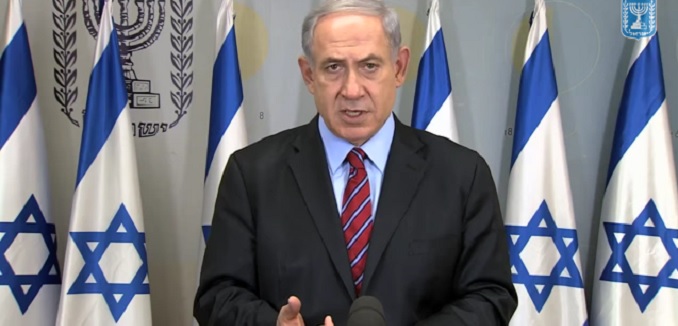Israeli Prime Minister Benjamin Netanyahu on Thursday predicted that “more stages were expected” in the country’s three-day-old Operation Protective Edge, as analysts converged on the assessment that Israel may have to initiate a ground incursion into the Gaza Strip in the wake of a series of moves by the Palestinian Hamas faction, which controls the territory and has over the last few weeks steadily increased rocket attacks against the Jewish state:
The prime minister gave no indication of when or whether ground troops would be committed to the campaign, nor what steps needed to be taken by the other side for Israel to halt the operation.
One official said it was clear that what Israel might have accepted two weeks ago in terms of “quiet for quiet,” it would not accept now. Netanyahu, the official said, would not agree to a situation whereby yet another cease-fire would be declared, which Hamas would then take advantage of to “tend to its wounds” and restock missiles for the next round.
Netanyahu is widely acknowledged as having sought to deescalate tensions before the operation began – Palestinian sources confirmed as much earlier this week, and even domestic critics of Netanyahu’s diplomacy have bluntly stated that he “did not want to escalate this war” – but observers on Thursday identified a range of Hamas actions that risked precipitating a wider conflict.
Uzi Rubin, the former director of Israel’s Missile Defense Organization, had explained to reporters on Wednesday conference that Hamas was apparently “preparing for a long campaign.” Speaking on a conference call hosted by The Israel Project, Rubin specifically cited the pace at which Hamas was depleting its rocket inventory as evidence that the terror group was digging in for a long operation.
Hamas on the same day launched three rockets at Israel’s nuclear reactor in the city of Dimona, a blackletter act of nuclear terrorism per binding United Nations conventions.
Rockets fired by the group on Thursday were intercepted within a few miles of Israel’s main airport.
Meanwhile Amos Yadlin – the former head of the IDF’s military intelligence shop (Aman) and currently the director of Tel Aviv University’s Institute for National Security Studies (INSS) – published a broad overview of the strategic situation surrounding the conflict. He specifically noted that Hamas had created “a network of underground tunnels and shelters, which are used not only by the Hamas leadership but also by a large number of military operatives”:
A combined operation, with air and ground attacks, based on intelligence: The public tends to see only two models of action, aerial or aerial with a large scale ground operation to occupy Gaza. Yet even if we do not intend to occupy Gaza, a ground operation is necessary and almost essential. There is a high level of synergy between an aerial operation and a ground operation. Without a ground operation, Hamas will remain underground. A ground operation against high value targets will create friction with the terrorist organizations’ military wing and allow both an aerial and a ground force to attack them and their operational infrastructures.
The various factors appear to create a scenario in which Hamas has ensured that its long-range missiles – which it is preparing to deploy over the course of months against Israeli civilian centers and nuclear installations – are functionally invulnerable except from the ground.




